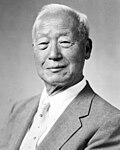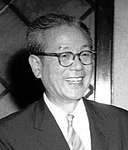President
Popular hopes of unseating Rhee were frustrated by the death of his opponent Cho Pyong-ok several weeks before the election, leaving Rhee to be elected without opposition. [5]
The constitution stated, if there was only one candidate, they were required to receive at least 30% of the total votes cast in order to be elected, including blank and invalid votes. As the only candidate, Rhee received 88.7% of all votes cast. Dissent to the authoritarian president was more apparent in the urban areas than the rest of the country. In Seoul, nearly a third of the votes were invalid or blank, while in the vice presidential election held simultaneously, only 2.9% of the ballots were invalidated. [6]
| Candidate | Party | Votes | % |
|---|
| Syngman Rhee | Liberal Party | 9,633,376 | 100.00 |
| Total | 9,633,376 | 100.00 |
|
| Valid votes | 9,633,376 | 88.69 |
|---|
| Invalid/blank votes | 1,228,896 | 11.31 |
|---|
| Total votes | 10,862,272 | 100.00 |
|---|
| Registered voters/turnout | 11,196,490 | 97.01 |
|---|
| Source: Nohlen et al. |
By region
| Region | Syngman Rhee | Invalid | Abstained | % |
|---|
|
|---|
| Votes | % | Votes | % |
|---|
| Seoul | 684,146 | 66.0 | 264,193 | 25.5 | 87,577 | 8.5 |
|---|
| Gyeonggi | 1,139,927 | 84.9 | 168,401 | 12.5 | 34,990 | 2.6 |
|---|
| Gangwon | 829,131 | 94.0 | 44,665 | 5.1 | 7,902 | 0.9 |
|---|
| North Chungcheong | 510,369 | 86.2 | 66,068 | 11.2 | 15,855 | 2.7 |
|---|
| South Chungcheong | 988,180 | 90.7 | 68,952 | 6.3 | 32,755 | 3.0 |
|---|
| North Jeolla | 919,529 | 87.8 | 113,640 | 10.8 | 14,619 | 1.4 |
|---|
| South Jeolla | 1,398,887 | 92.0 | 108,902 | 7.2 | 12,802 | 0.8 |
|---|
| North Gyeongsang | 1,403,461 | 83.9 | 203,105 | 12.1 | 66,956 | 4.0 |
|---|
| South Gyeongsang | 1,632,159 | 86.7 | 190,158 | 10.1 | 60,249 | 3.2 |
|---|
| Jeju | 127,587 | 99.0 | 812 | 0.6 | 513 | 0.4 |
|---|
| Total | 9,633,376 | 86.0 | 1,228,896 | 11.0 | 334,218 | 3.0 |
|---|
|
|---|
| Source: National Election Commission [7] |
Vice president
With no competition for Rhee in the presidential elections of 1960 after the death of his opponent, the simultaneous vice presidential elections became the main focus of attention. Opposition to Rhee was concentrated around the incumbent Democratic Party candidate, Chang Myon, who had been elected in 1956. [2] Official results after the election showed a large victory for the Liberal candidate, Lee Ki Poong, with a margin of almost 80% to Chang's 17.5%, entirely against popular expectations, and it was obvious that the results had been extensively manipulated: Han goes so far as to say that "the election results were completely fabricated by police headquarters and the ministry of internal affairs". [2]
The Democratic Party rejected the result and on the same day, protests began in Masan against the fabrication of the election results. The discovery of the mutilated body of a sixteen-year-old boy who had participated in these protests in early April caused a wave of further protest, and Rhee's obdurate attitude led to the intensification of unrest into the April Revolution, [8] though Rhee forced Lee to withdraw from active politics. [9] The results of the elections were nullified after the Revolution's triumph later in the year, though Chang himself resigned on April 23. [10]
By region
| Region | Lee Ki-poong | Chang Myon | Kim Chun-yon | Louise Yim |
|---|
| | | |
|---|
| Votes | % | Votes | % | Votes | % | Votes | % |
|---|
| Seoul | 509,693 | 55.3 | 378,399 | 41.1 | 20,154 | 2.2 | 12,704 | 1.4 |
|---|
| Gyeonggi | 955,804 | 75.6 | 278,686 | 22.1 | 20,372 | 1.6 | 8,771 | 0.7 |
|---|
| Gangwon | 786,595 | 91.6 | 64,743 | 7.5 | 5,468 | 0.6 | 1,543 | 0.2 |
|---|
| North Chungcheong | 437,883 | 78.6 | 98,583 | 17.7 | 15,196 | 2.7 | 5,165 | 0.9 |
|---|
| South Chungcheong | 884,856 | 84.7 | 140,567 | 13.5 | 12,488 | 1.2 | 6,327 | 0.6 |
|---|
| North Jeolla | 851,878 | 85.5 | 89,846 | 9.0 | 32,176 | 3.2 | 22,799 | 2.3 |
|---|
| South Jeolla | 1,218,247 | 83.8 | 140,664 | 9.7 | 80,491 | 5.5 | 13,612 | 0.9 |
|---|
| North Gyeongsang | 1,166.341 | 75.5 | 340,214 | 22.0 | 27,759 | 1.8 | 11,286 | 0.7 |
|---|
| South Gyeongsang | 1,398,637 | 79.5 | 311,320 | 17.7 | 34,869 | 2.0 | 15,284 | 0.9 |
|---|
| Jeju | 127,125 | 99.3 | 736 | 0.6 | 122 | 0.1 | 42 | 0.0 |
|---|
| Total | 8,337,059 | 79.2 | 1,843,758 | 17.5 | 249,095 | 2.4 | 97,533 | 0.9 |
|---|


